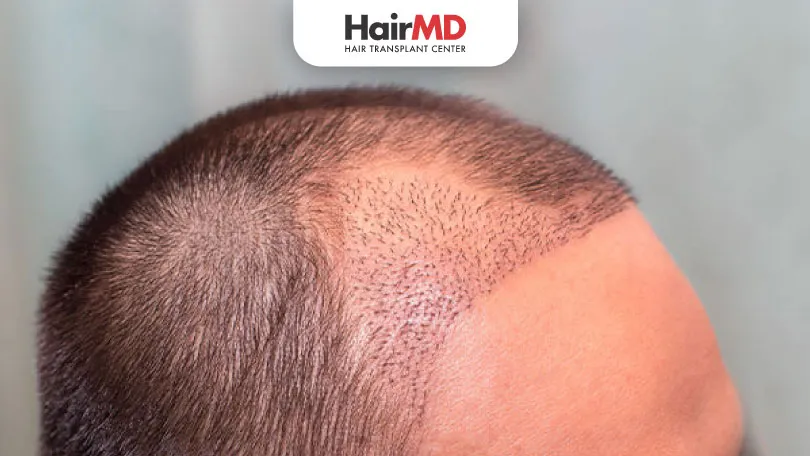9th July, 2022

Hair transplant surgery is a popular solution for hair loss, but many patients experience some shedding of transplanted hair after the procedure. This is a normal part of the healing process known as “shock loss.”
While this temporary shedding may raise concerns, it’s crucial to understand that the transplanted follicles will eventually grow back healthy and strong. Factors such as post-surgery care, graft quality, and individual reactions all play a role in this process. To ensure optimal results, it’s essential to follow your surgeon’s post-operative guidelines.
What’s covered in the article?
- Does transplanted hair fall out?
- Causes for hairloss after transplant
- Transplanted hair shedding: How to care for transplanted hair?
- Conclusion
Does transplanted hair fall out?
In today’s cosmetic era, a hair transplant is a permanent and effective solution for baldness. If you are thinking to do a hair transplant, then you should know that transplanted hair does fall out, which is common and temporary. Hair fall is a natural function of the body and it is common to lose between 80-100 hairs every day. The important thing is to know the difference between normal hair shedding and shedding after a hair transplant of the transplanted hair grafts. You should also know the factors affecting the loss of transplanted hair.
Let me explain to you in detail about hair shedding.
Normal hair shedding:
As we all know our hair goes through the cycle of three phases of shedding and growth at all times in our lifespan: anagen, catagen, and telogen phases. These three phases occur simultaneously; one strand of hair may be in the anagen phase, while another in the telogen phase.
Shedding after hair transplant:
A lot of patients complain of hair shedding post hair transplant. Not many of us know that shedding of hair is a completely normal occurrence and is vital for strong hair to grow on the scalp.
The anagen phase: It is known as the growth phase and can last from two to six years.
The catagen phase: This is also known as the “transitional phase”, which lasts for 2-3 weeks.
The telogen phase: In this phase, most shedding occurs and can last for about 100 days. During this time, normally 80-100 hairs can shed.
Let’s check why does transplanted hair fall out?
Causes for hairloss after transplant
1) Shock Hair Loss:
During a hair transplant, small incisions are made, then the individual grafts are placed. For your hair transplant, FUT or FUE is performed. The procedure is traumatic on the scalp and the surrounding hairs. As a result, your hair grafts and the existing hairs can temporarily shed which is known as shock loss.
You should not be scared if you notice the continued loss of hair, which will occur between 1-5 weeks after the hair transplant procedure. Within a short time, new hairs will eventually grow back again. Understand that “shock loss” is a normal part of hair restoration development and although it is unavoidable, it is also temporary.
2) Graft Rejection:
As a matter of fact, no doctor can give you a 100% guarantee on the occurrence of graft rejection. Many times, the recipient area might reject the donor grafts completely. In this case, the body’s immune system rejects the hair grafts and destroys the transplanted tissue completely.
3) Post hair transplant care:
The post-care is a must for hair transplants. You need to listen to your doctor and pay special attention to post-operative care or else it may lead to the destruction of the transplanted grafts.
Some of the steps that you need to keep in mind are:
· Wash your hair thoroughly but gently.
· Abstain from alcohol, sex, and nicotine for at least 1-4 weeks so that the grafts do not get dislodged.
· Post-operative care is of utmost importance to have a successful hair transplant otherwise, it will result in a complete waste of money and time
4) Telogen effluvium:
Telogen Effluvium is basically a hair loss where you end up losing all of your hair at once. It mostly occurs due to various external factors that can cause hair follicles to fall out. We at HairMD, consider each case on an individual basis and provide the best solutions to treat the problem.
5) Low-Quality Donor grafts:
Since there are many hair transplant clinics, many do not always come with the provision of high quality and experience. Many of them end up extracting hair from non-permanent zone to place in the recipient area. That’s when transplanted hair falls out completely resulting in total hair loss. Therefore, it is very important to go to an experienced doctor, who knows which is the perfect donor zone to carry out the hair transplant procedure.
Should you be worried about hair loss after a transplant?
Donor dominance & Recipient dominance theories: Why transplants work for hair loss?
Coined by Dr Norman Orentreich, the Donor Dominance theory explains why hair tissue from the donor zone successfully regenerates new hair. Watch what our hair transplant surgeon, Dr Shivanee has to say about the Donor Dominance & Recipient Dominance Theories in hair transplant. This will give you an idea of the scientific basis of why hair transplantation is an effective solution.
Transplanted hair shedding: How to care for transplanted hair?
The major reason why does transplanted hair falls out is the decrease of blood flow to the grafts. But does transplanted hair always fall out? Yes, this is universal for everyone undergoing a hair transplant procedure. Only a small percentage of people will not experience hair shedding after the procedure. For everyone else, the transplanted hair stays on the scalp for a few months after which new hair starts coming out. The result of hair restoration from the procedure won’t be affected whether the individual sheds or not.
There are a few ways to minimize the effects of effluvium or post-operative shedding, which are mentioned as follows.
Medication: The dermatologist or doctor may prescribe Propecia (finasteride) to reduce the risk of excessive shedding grafted hair after transplantation. Many studies have shown that the use of Propecia can slow down or even reverse the miniaturization of hair follicles in individuals and prevent shedding.
Timing of the procedure: It is crucial to decide the right timing before going for the hair transplant procedure. Individuals must plan their surgery in a way such that they have sufficient hair grafts available to compensate for any shedding.
Many patients seek hair transplant when they have visible hair loss in its early stages along with significant miniaturization. The problem here is the doctor may perform the procedure without taking into consideration the progression of the hair loss or the possibility of future shedding. Consequently, the patient will experience thinner hair than they had before the procedure.
Hence, the best way to approach hair loss is beginning with medications, and sometime later when the patient is ready for the surgery, plan the hair restoration process leaving enough grafts to make a significant improvement, in case further hair loss or miniaturization occurs.
Cosmetics: If the patient is bothered cosmetically due to the thinning, cosmetic camouflage may be used after the surgery temporarily. Once the transplanted hair starts growing, its use can be discontinued.
Transplanted hair falls out if you don’t take care of them. It is very important to carefully understand the aforementioned points and get proper guidance from your doctor to make the best of your transplanted hair.
To know more about which medicines to take after hair transplant for maximum results so you keep following proper follow up with your dermatologist after surgery.
For queries and concerns regarding hair loss treatments and hair transplants, book your consultation with a HairMD expert.
Do You Know?
Nearly 250 Patients Visit HairMD
Everyday For Various Hair Concerns?
(Your journey to healthier and fuller hair starts here!)
Meet Our Dermatologists
Conclusion
Transplanted hair typically falls out after surgery, a common and temporary process known as “shock loss.” This occurs within 1-5 weeks as the scalp heals, but the transplanted follicles regrow healthy hair after a few months. Proper post-operative care, selecting quality donor grafts, and considering factors like telogen effluvium or graft rejection are essential to success. Consulting an experienced doctor and following recommended medications can help minimize hair shedding and enhance the transplant results.
Further Reading
Top Kitchen Ingredients to Boost Hair Growth
Discover the best kitchen ingredients for hair growth! Use coconut oil, onion juice, aloe vera & more to nourish your hair naturally and reduce hair fall.
How to Treat Alopecia Areata at Home: Natural Solutions for Hair Growth
Explore home remedies for alopecia areata to promote hair regrowth and boost confidence from home.
Redensyl vs. Minoxidil: Which is the Better For Hair Growth?
Discover the differences between Redensyl and Minoxidil for hair growth. Learn about their effectiveness, side effects, and which treatment might be better for you.
Biotin-Rich Foods for Natural Hair Growth
Know the best foods rich in biotin to help your hair to grow naturally stronger and healthier by experts from HairMD, Pune
Have thoughts? Please let us know
We are committed not only to treating you, but also educating you.











